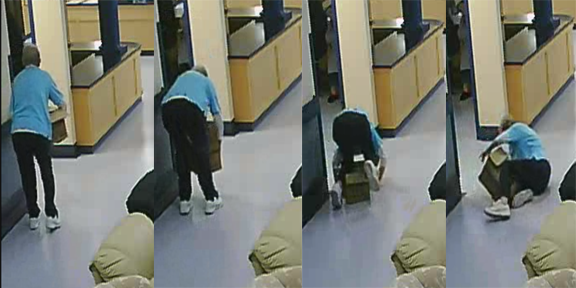By Mr Peter Hong, Ms Helen Chong, Dr Vicki Komisar and Dr Steve Robinovitch
The COVID-19 pandemic has created challenges to the ISPGR research community, especially in the collection of new data with human participants. The pandemic has also highlighted the value of shared databases for reuse by other research groups. The Technology for Injury Prevention in Seniors (TIPS) team at Simon Fraser University hopes to foster innovation in the prevention of falls and fall-related injuries in older adults, by sharing a dataset of video footage of real-life falls experienced by older people.
Falls are the number one cause of injuries, and a major barrier to mobility for older people, especially in long-term care. Many ISPGR members pursue research on the cause and prevention of falls in older adults. Yet rarely are we able to draw on objective evidence on how falls occur. Video footage of falls in older adults provides a wealth of information on the circumstances of falls to drive innovation (Robinovitch et al, Lancet, 2013).
The TIPS program at Simon Fraser University (SFU), in partnership with the Fraser Health Authority and two long-term care homes in the Greater Vancouver Area, has recently posted to the Databrary Network an expanded dataset of videos of 239 real-life falls experienced by older adults in long-term care homes. The videos can be accessed at: https://nyu.databrary.org/volume/739.
Databrary is an online data repository, hosted by New York University, that allows for sharing of video data for reuse in research and teaching by investigators associated with an institution having an Institutional Review Board (IRB) for human participant research. To date, Databrary has users from 616 institutions in over 25 countries, and TIPS’s falls videos collection is currently being used by researchers in Canada, Europe and the US. Visit the Databrary website ( https://nyu.databrary.org/user/register?page=create) for extensive instructions on gaining access.
The 239 falls posted to Databrary were selected from a larger pool to represent the range of falls we have observed in long-term care, with respect to: fall direction, activity at time of falling, biomechanical cause of the fall, sex of the individual falling, height of the fall, use of mobility aids, frequency of head impact, and frequency of pelvis impact. The 239 falls were experienced by 100 individuals of mean age 83.3 years (SD = 7.4), all of whom were residents of the two long-term care homes. 52 women accounted for 152 falls, and 48 men accounted for 87 falls. All falls occurred in common areas (hallways, dining rooms, lounges). For 111 of the 239 falls, at least two camera views captured the fall, which could allow for subsequent 3D kinematic analyses.
In addition to the video footage, the Databrary dataset includes Excel spreadsheets that allow you to search the dataset based on: the number of camera views, the frame rate and resolution of the video, characteristics of the resident falling (age, sex, height, weight), injuries associated with the fall, use of mobility aids, biomechanical cause of the fall, and the activity at the time of the fall. For those residents who provided consent, we include data on medications and disease diagnoses.
TIPS hopes to foster innovation in geriatric falls research and education by sharing the falls video database with researchers, healthcare professionals, and educators. The dataset may be particularly relevant for researchers pursuing sensor-based fall detection, and the design of exoskeletons, assistive devices, environmental modifications, and wearable protective gear. The dataset should also help to inform more externally valid approaches to assess postural stability and risk for falls in older adults.

Figure 1. Example of fall sequence captured by video footage in a long-term care home.
References and example publications related to the real-life falls database:
Komisar, V, Shishov, N, Yang, Y, Robinovitch, SN. (2020) Effect of Holding Objects on the Occurrence of Head Impact in Falls by Older Adults: Evidence From Real-Life Falls in Long-Term Care, The Journals of Gerontology: Series A, glaa168, https://doi.org/10.1093/gerona/glaa168
van Schooten KS, Yang Y, Robinovitch SN (2018). The association between fall frequency, injury risk and characteristics of falls in older residents of long-term care: do recurrent fallers fall more safely? The Journals of Gerontology: Series A, Volume 73, Issue 6, June 2018, Pages 786–791, https://doi.org/10.1093/gerona/glx196
Robinovitch SN, Feldman F, Yang Y, Schonnop R, Leung PM, Sarraf T, Sims-Gould J, and Loughin M. (2013) Video capture of the circumstances of falls in elderly people residing in long-term care: an observational study. The Lancet. 381(9873): 47-54. https://doi.org/10.1016/S0140-6736(12)61263-X
About the Author

Peter Hong
Simon Fraser University
Peter is an undergraduate student at Simon Fraser University. He is working towards completing his BSc in Health Sciences. His research interests include the investigation of the pathophysiology of diseases associated with geriatric falls.

Helen Chong
Biomedical Physiology and Kinesiology department, Simon Fraser University
Helen is a Lab Technician and Research Manager at SFU. Her current interests include wearable protective gear and falls in older adults living in the community.

Dr. Vicki Komisar
School of Engineering, University of British Columbia
Vicki is an assistant professor at UBC, where her research program focuses on mobility, aging, and fall and injury prevention.

Dr. Steve Robinovitch
Biomedical Physiology and Kinesiology department, Simon Fraser University
Steve is a professor at SFU who runs the Technology of Injury Prevention in Seniors program, which is a unique university-community partnership for developing new technologies to prevent falls and fall-related injuries in older adults.
Copyright
© 2021 by the author. Except as otherwise noted, the ISPGR blog, including its text and figures, is licensed under a Creative Commons Attribution-ShareAlike 4.0 International License. To view a copy of this license, visit https://creativecommons.org/licenses/by-sa/4.0/legalcode.
ISPGR blog (ISSN 2561-4703)
Are you interested in writing a blog post for the ISPGR website? If so, please email the ISGPR Secretariat with the following information:
- First and Last Name
- Institution/Affiliation
- Paper you will be referencing


